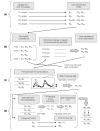Identifying combinatorial regulation of transcription factors and binding motifs
- PMID: 15287978
- PMCID: PMC507881
- DOI: 10.1186/gb-2004-5-8-r56
Identifying combinatorial regulation of transcription factors and binding motifs
Abstract
Background: Combinatorial interaction of transcription factors (TFs) is important for gene regulation. Although various genomic datasets are relevant to this issue, each dataset provides relatively weak evidence on its own. Developing methods that can integrate different sequence, expression and localization data have become important.
Results: Here we use a novel method that integrates chromatin immunoprecipitation (ChIP) data with microarray expression data and with combinatorial TF-motif analysis. We systematically identify combinations of transcription factors and of motifs. The various combinations of TFs involved multiple binding mechanisms. We reconstruct a new combinatorial regulatory map of the yeast cell cycle in which cell-cycle regulation can be drawn as a chain of extended TF modules. We find that the pairwise combination of a TF for an early cell-cycle phase and a TF for a later phase is often used to control gene expression at intermediate times. Thus the number of distinct times of gene expression is greater than the number of transcription factors. We also see that some TF modules control branch points (cell-cycle entry and exit), and in the presence of appropriate signals they can allow progress along alternative pathways.
Conclusions: Combining different data sources can increase statistical power as demonstrated by detecting TF interactions and composite TF-binding motifs. The original picture of a chain of simple cell-cycle regulators can be extended to a chain of composite regulatory modules: different modules may share a common TF component in the same pathway or a TF component cross-talking to other pathways.
Figures



References
-
- Zhang MQ. Large-scale gene expression data analysis: a new challenge to computational biologists. Genome Res. 1999;9:681–688. - PubMed
-
- Roth FP, Hughes JD, Estep PW, Church GM. Finding DNA regulatory motifs within unaligned noncoding sequences clustered by whole-genome mRNA quantitation. Nat Biotechnol. 1998;16:939–945. - PubMed
Publication types
MeSH terms
Substances
Grants and funding
LinkOut - more resources
Full Text Sources
Molecular Biology Databases
Miscellaneous

